While conditions in Lee Vining are thin this January, we still found fun things to climb.
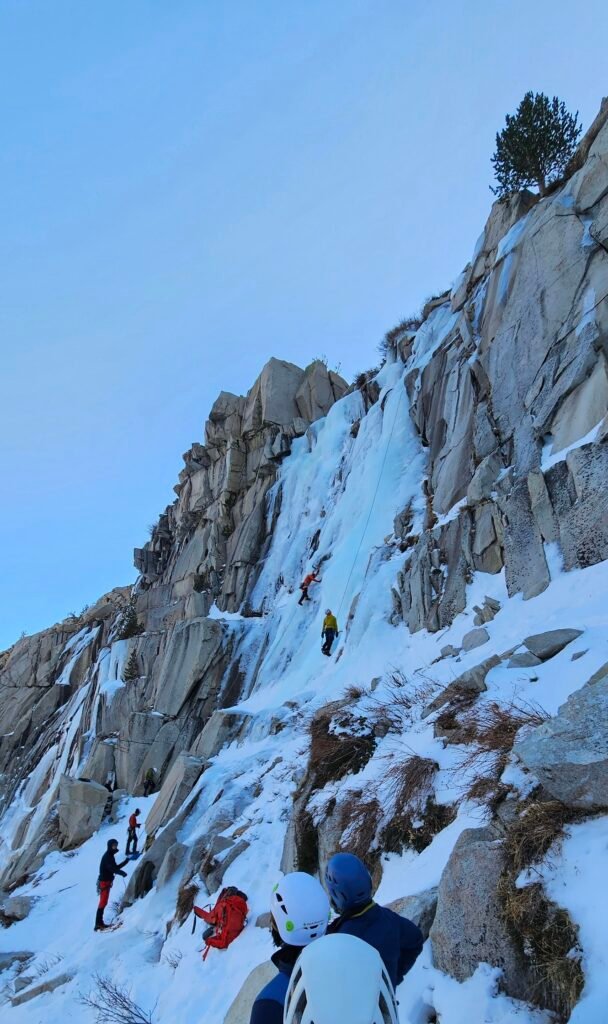
Mid-January, I took a trip to Lee Vining to take an Intermediate Ice Climbing course with International Alpine Guides.
It’s been warm lately in the Eastern Sierras, with temperatures peeking up into the 40s, and it was 50F degrees the Friday before I went. But the temp was supposed to drop to 19F at night, which I hoped would restore the ice.
I waited all week for a call to tell me the conditions wouldn’t be right and it wouldn’t happen. I had fully accepted the course could get canceled, since an earlier trip I’d booked with the same company in late December had been called off due to the thin conditions. They’d issued me a weather credit so I’d immediately re-booked.
But an email came in from my guide on Thursday. The course was on. Conditions were thin, the guide said—but it was on.
We’d be at Lee Vining both days. This jived with info I’d received from an ice buddy I met at the climbing gym, who told me he’d heard from his Reno friends that a certain pipe that helps supplement the ice near June Lake wasn’t flowing this year. (If you ever want to make ice climbing friends, just wear a Ouray Ice Fest shirt to the rock climbing gym.)
I drove in at night, and the moon was so bright I could see the white mountains to my left as I cruised into Lee Vining from Bishop. One of the only cars on the road.

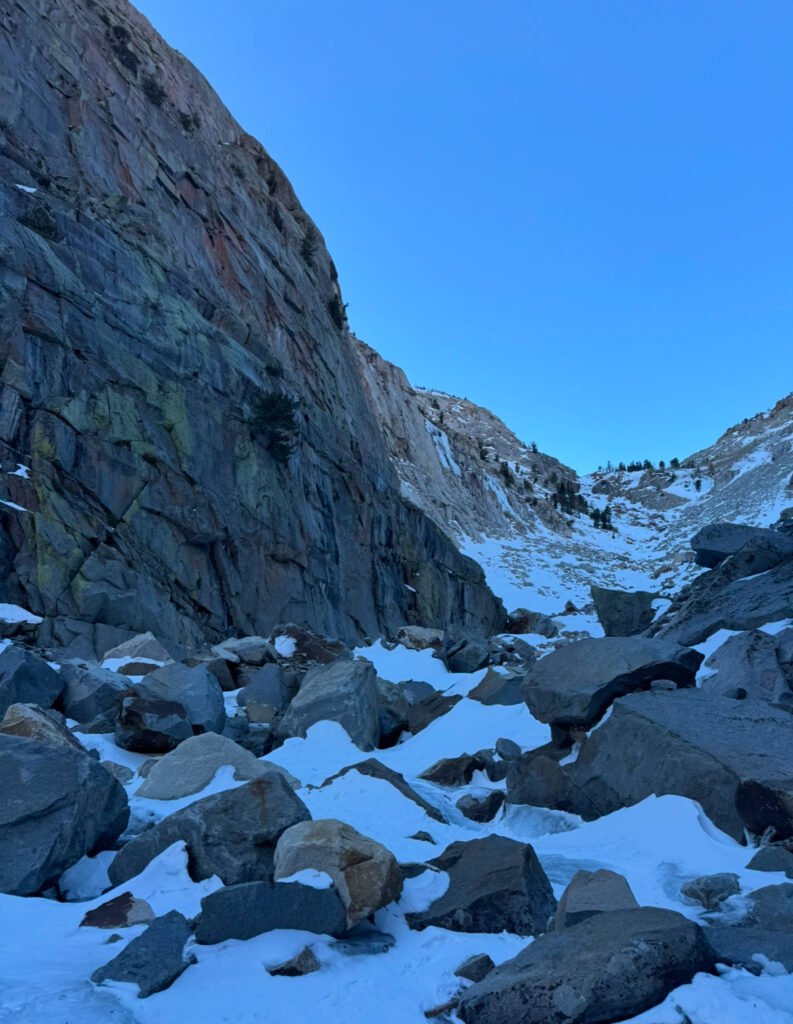
The Climbing Conditions
There were just 3-4 lines open on Chouinard’s, and the middle was a little wet. Over the course of the two days, we mostly did laps on three WI3+ routes.
The “3 Stooges” section to the right of Chouinard’s wasn’t in at all and looked more like a regular rock crag, though a tiered WI2 or 3 looking route to the far right was starting to come in.
We didn’t climb at Main Wall, but there were a couple parties over there, who’d hiked around and managed their system from the top. The bottom looked a little thin in spots but was starting to fill in more.
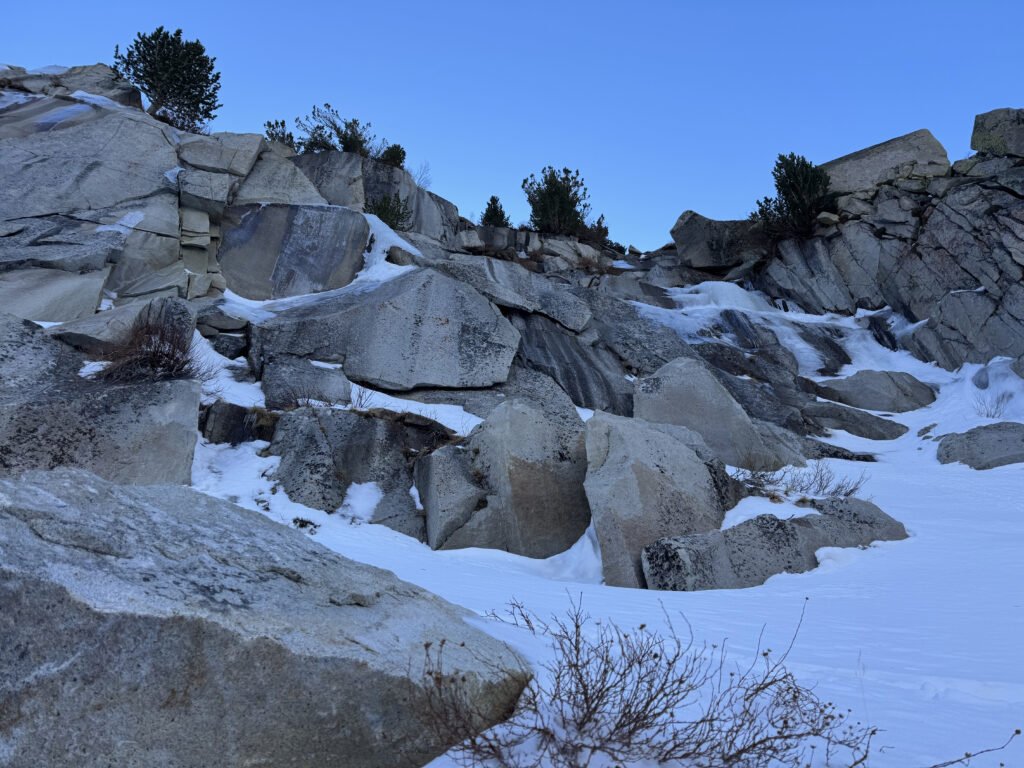
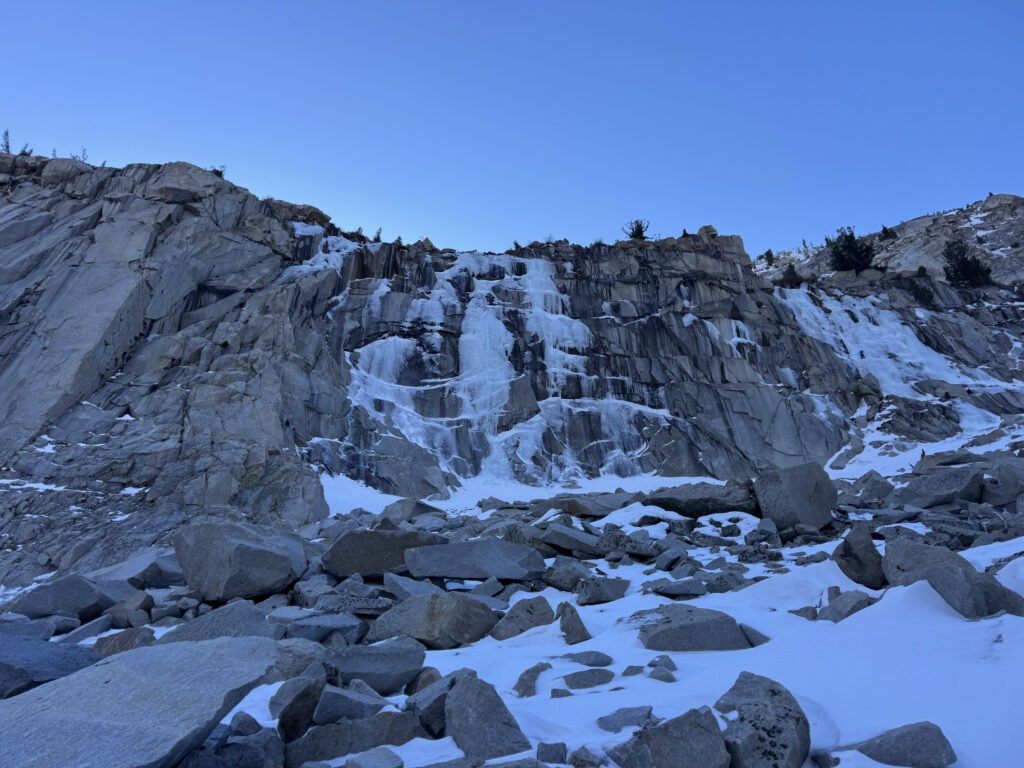
Approach into Lee Vining
In the morning, we met at the Tioga Pass Mobil as the sun was starting to peek up. We carpooled to the trailhead on an icy road.
“Sometimes, this parking lot is an ice rink,” our guide said, “so it’s nice to have sharpy bits on your feet when you get out of the car.”
We doled out gear, donned snowshoes, and began the approach up and into the canyon towards the ice. I carried one of our ropes. “78 meters,” the guide said. I wondered what happened to the other 2. Later, we’d find out a new climber had taken a swing with an ice tool and nailed the rope. “Brand new 80 meter rope,” our guide said, shaking his head. Seventy-eight meters now.
My borrowed snowshoe came off in the first 5 minutes of the hike after climbing over a downed tree branch that blocked the trail.
“Keep it really, really tight,” my guide said. It had been a minute since I’d worn snowshoes (or more like 4 years). I felt quite Californian. We went on, snowshoes flopping.
The approach into Main Wall and Chouinard’s Wall is about 0.7 miles, up maybe 700 ft from the Edison Power Plant. It involves a minor bit of boulder hopping, depending on snow conditions. There was enough packed down snow to avoid most awkwardness. We crossed some small streams in our snowshoes, balancing on the rocks. Per usual, I forgot to hit stop on my Garmin recording, but it took roughly 45 minutes, with minor stops as our group of 5 moved at different paces. The last little bit up into the canyon was the steepest and decently strenuous and made me understand why their fitness requirement is that you be in “excellent shape.”
Our guide, Tim, reminded us this is a prime rockfall zone, and in snowier conditions, an avalanche corridor.

The Course
Because of how crowded it was, we only had 1 line set up on the first day. And it was many hours before I climbed. I stayed warm in my Arcteryx Atom Hoody, Himali Accelerator, and most importantly my new Arcteryx Nuceli SV belay parka which I came to depend on as someone who runs cold.
We reviewed the basics of technique and some footwork like crossovers. Then our guide set up a top rope (just 1 as there were 2 other parties) and we began laps. I think as a whole we skewed a bit more beginner than true intermediate, so the focus of the course became more about refining technique and time on ice than mock leading or screw placements. One guy who’d been ice climbing for several years did mock lead.
As far as technical takeaways, this trip emphasized the importance of using that second position on the tool for me. I began to see how it could improve efficiency, especially over bulges. Our guide also emphasized the importance of not chicken winging in the lockoff position but keeping your elbow in.
One highlight was I got to try out Grivel Rambos. I liked the mono point on them but had never tried a rigid crampon before (non-modular) and found them uncomfortable to walk in when we wore our crampons on the descent and hike back to the parking lot.
With the Grivel Rambos, I found my heel lifted in my new Scarpa Phantom Tech HDs, but they didn’t do that as much with modular crampons like the Petzl Lynx. Our guide suggested this was because the Rambos have less flex than other crampons due to their rigid design. This creates a more stable feeling footbed or platform for steep ice, but can cause more heel lift as the crampon-boot-foot system looks for somewhere to flex with the force on it.
Trying Out Tools
Tim let me try out his Camp X Dreams because I’d been debating between the X Dreams and Petzl Nomics. He calls the X Dreams “cheater sticks.” They have a little more reach than the Nomics, and felt similar, though his had pick weights so they were heavier than the Nomics I used. The handles are also bigger on the X Dreams, with a more prominent second position. I couldn’t quite tell which I liked better.
“How do those crampons feel?” He asked, referring to the Grivel Rambos he let me borrow.
“Awesome!” I replied. In comparison to the dull Lynx crampons I’d been using, it felt like a world of difference. I could actually stick into the ice instead of feeling like I was smearing in shoes.
A few meters later up the pitch, he called. “And how do those tools feel?”
“So awesome!” I replied again. Anything was better than the BD Vipers I’d been using.
He laughed. “I guess everything is awesome today!”
It was. And how could it not be in the Eastern Sierras?
I also tried the Grivel Dark Machines but found their straight-ish, non-featured handles more tiring for my small hands which felt more slip-slidy on those tools. Maybe wrapping the handles would fix that.
Surprise Dry Tooling
The second day, our guide set up an M4+ route that was mostly dry tooling up the bottom section into some very thin ice. The route, if it were just rock, probably would’ve been 5.4. It looked super easy from the ground.
But I quickly found learning to trust my tiny mono front points on thin edges of rock felt sketchy. Trying to torque a tool in a crack felt good and solid sometimes but could slip so easily if you stopped torquing at the perfect angle.
It was my feet that felt most insecure dry tooling. I made my way up into a narrow v-like chute that would probably be 5.3ish and that I would’ve blazed up on rock. But I was extremely conscious of moves that made my feet come close together, lest I slip and stab my own ankle with my own crampons. After a few top rope falls I made it to the thin ice section at the top and had never been so relieved to see ice, even if it was a narrow little vein on the rock. I was completely pumped by the top, as if I’d done a hard sport route. M4+ kicked my butt. I found fewer opportunities to actively rest on the mixed route, perhaps because I trusted every placement less.
I’d felt so epic on the route, but a photo snapped by one of my fellow course mates shows me looking desperate, almost bear hugging a block created by two cracks in the rock, butt out. I’d post it, but the internet doesn’t need to have that.
Nothing was open in Lee Vining as far as food goes, so after the long climbing day, I stuck with my trusty Shin Black Ramen. The beef bone broth kind.
Leaving Lee Vining
We wrapped our two day course on Sunday around 4pm.
As I left and started heading back, towards South Lake Tahoe, the sun was starting to set over Mono Lake and the surrounding mountains.
I had to pull over to take a picture.
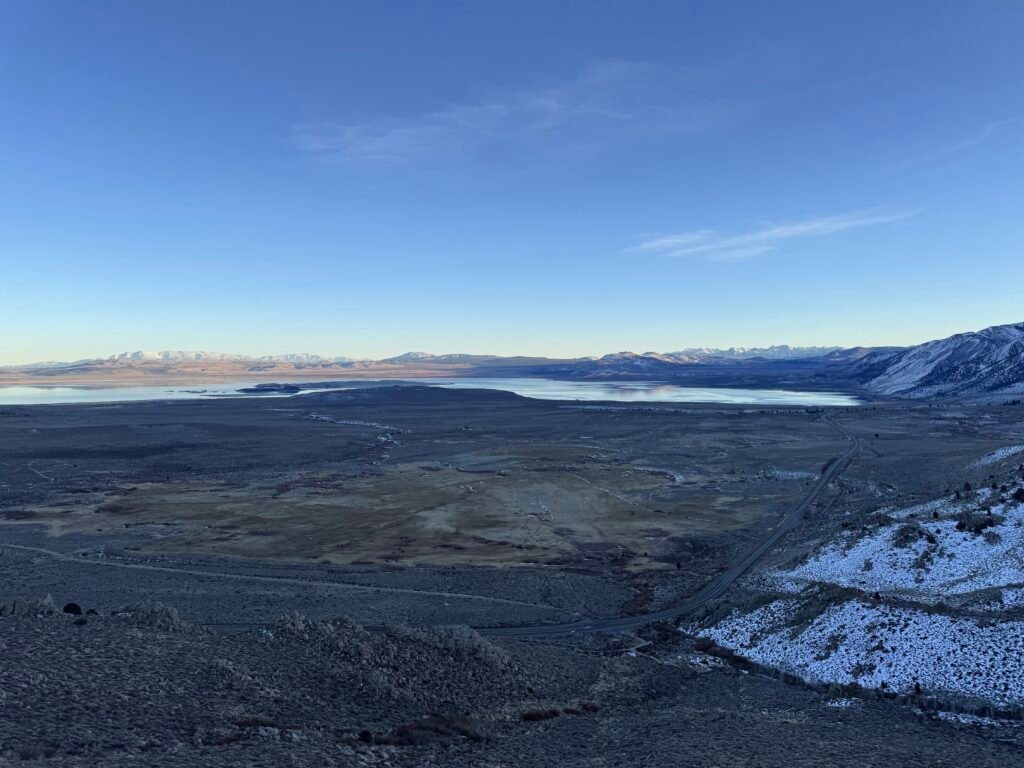
I pulled off into a turnout, hit my hazards, and ran across Highway 395. I hopped a guardrail and snapped a pic, feeling incredibly free, sore, and elated. How I always feel in the mountains.
Immediately after, I hit my inner thigh hard on the guardrail as I tried to step back over. Inelegantly tripping.
A semi passed, witnessing my grace with a big rattle of metal and wind and inertia. I hobbled back to my car and cranked up a Maggie Rogers mix.
Tips for first time ice climbers:
- Keep your gloves in your jacket. Even if you’re swapping gloves really quickly.
- Bring Hot Hands as you can put them in your gloves and take them out when you go to climb.
- Fill Hydroflasks or thermoses with hot water.
- Keep a snack in a pocket so it doesn’t freeze. Eat before you get hungry to avoid an energy bonk.
Where to Stay in Lee Vining for Ice Climbing
Where to Eat
- Your hotel room. Almost nothing is open in Lee Vining in winter. Or head to June Lake or Bridgeport.
